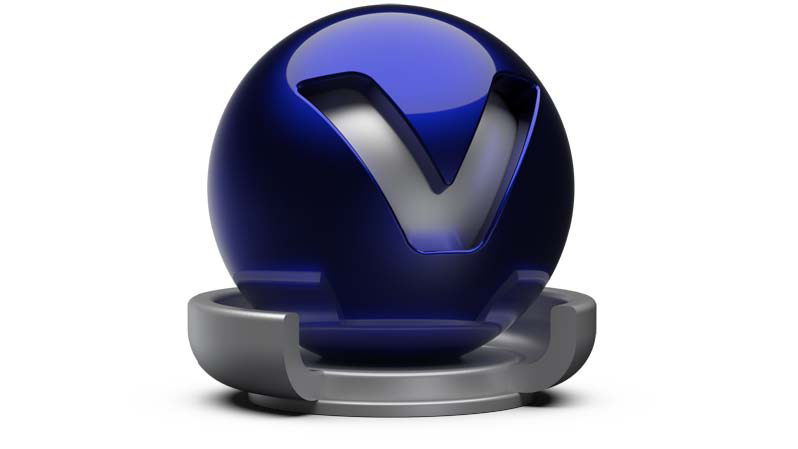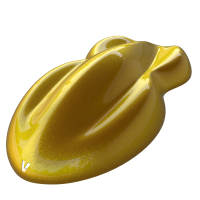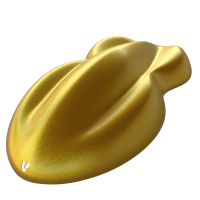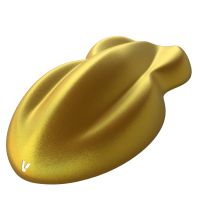Metallic Carpaint

A metallic car paint material has small particles made of metal, or flakes, on top of its lacquer layer. These particles increase the brightness within the angle of incidence, causing a light textured look. The color and size of the flakes is customizable.
The basic structure of this kind of paint consists of a mix of three or four different layers.
The base layer is a solid diffuse colored layer at the bottom to give a constant colored basis, independent from the actual material it is applied to. Usually, grey is used for this layer.
The second layer is the Primary Flake Layer. It contains both colored diffuse pigment particles that give the basic color impression and randomly distributed flakes.
The third layer is the Secondary Flake Layer. Its attributes are identical to the attributes of the Primary Flake Layer.
The last layer is the Clearcoat Layer, which is a specular layer. It can also have colored pigments in it.
Video captions: Create a Metallic Carpaint material and assign it to geometries in your scene. In this case, you can replace your current varnish with Ctrl+ M and Ctrl + N. You can find the same material settings as in the Unicolor Paint material, but additionally, the Flake settings appear. The Flake Color determines the color of the small metallic shapes. Therefore, the color of the varnish is a combination of the Base Color and the Flake Color. With Flake Size you determine the size of the metallic flakes. Choose a value that fits your future resolution. Roughness enables you to define the roughness of the varnish. This value is responsible for the light distribution over the flakes. Flake Intensity regulates the intensity of the flakes.
Metallic Carpaint Material
Paint Types - Sets the type of carpaint to simulate. Choose from three types:
- Artistic - A simplified approach will be used on modelling carpaint. This paint material will consist of three layers (Base, Primary Flake and Clearcoat Layer)
- 2-Coat - A more realistic approach will be used on modelling carpaint. This paint material will consist of three layers (Base, Primary Flake and Clearcoat Layer).
- 3-Coat - A more realistic approach will be used on modelling carpaint. This paint material will consist of four layers including two flake layers on top of each other (Base, Primary Flake, Secondary Flake and Clearcoat Layer).
Base Color - Sets the diffuse base color of the carpaint. If the paint type is set to Artistic this sets the diffuse color. For 2 and 3 coat paints this is the color of the base layer beneath the flake. Use the slider to change the brightness. Click the color field on the right to open the color chooser.
Primary Flake Layer
Set the behavior of the pigment particles and flakes.
Pigment Color - Sets the pigment’s color, which gives the basic color impression of this layer.
Pigment Concentration - Sets the density of pigments by controling how many particles are present in the layer.
Flake Color - Defines the color of the metallic particles on top of the lacquer layer. It gets stronger and more brilliant the further the normal orientation points away from the camera.
Use Flip Flop - Uses flakes with a Flip Flop behavior. If this box is selected, two more attributes become available:
Flip Flop Flake Color - Only available when Use Flip Flop is enabled. Sets the metallic shiny flake’s second color. It gets stronger and more brilliant the further the normal orientation points towards the camera.
Flip Flop Blend - Only available when Use Flip Flop is enabled. Defines the mixture ratio of the two flake colors. If the slider is dragged to the right, the intensity of the basic Flake color will be increased. If the slider is dragged to the left, the intensity of the Flip Flop Flake Color will be increased.
Flake Roughness - Sets the roughness of the flake surfaces. A lower value represents a smoother surface, resulting in more specular reflections, while a higher value represents a rough surface, resulting in more diffuse reflections.
Flake Reflectivity - Sets the flake’s reflective intensity.The higher the value, the more reflectivity of the flakes in the paint.
Flake Size - Sets the flake’s size. The higher the value, the larger the flakes in the paint.
Flake Perturbation - Sets the randomness of the flake’s orientation. This addes a glitter effect to the paint.
Flake Density - Only available when a 2- or 3-Coat paint type is selected. Sets the concentration of the flakes by controlling how many flakes are present in the layer. If the density is set to 0, no flakes are present and the paint represents a unicolor paint.
Clearcoat
Sets the clearcoat color. The clearcoat is a transparent, highly reflective paint layer on the base metal layer.
Type - Defines the intensity of a reflection, based on the viewing angle. Its intensity at normal incidence is set by the material's reflectivity. Choose from the following:
- Off - Turns off the clearcoat.
- Fast - Uses a fast, but less accurate, approximation to the Fresnel Term (Schlick approximation) to create the clearcoat layer.
- Accurate - Uses a physically accurate evaluation of the Fresnel Term (Cook-Torrance approximation) to create the clearcoat layer.
Color - Sets the pigment color of the clearcoat, which slightly darkens the overall color of the brushed metal.
Refraction Index - Sets the material's refraction index. The index of refraction allows glass-on-glass contact situations. It shows the amount the rays are reflected off the surface versus absorbed (refracted into the surface).
Roughness - Imitates clearcoat spray paint high-gloss satin and matte finishes in rasterization and raytracing. Now, you can control the roughness, thickness, and density of the clearcoat for most materials, such as Plastic, Brushed Metal, Metallic Carpaint, and Carbon (2D/3D).
Roughness of 0 Roughness of 0.1 Roughness of 1.0 

 Video Player is loading.
Video Player is loading.
Video captions: Additionally, we have added now more advanced clearcoat options to all materials that can have a clearcoat. Now, you can achieve interesting satin paints in OpenGL using the new Roughness slider.
Thickness - Sets the thickness of the clearcoat.
Density - Determines the concentration of particles in the clearcoat, which affects the color of the clearcoat. Use this in combination with Thickness and a non-white color, as white is completely transparent.
Use Orange Peel - Applies a bump structure to the layer. Use the following options to customize this:
Orange Peel Frequency - Sets the bump structure's noise frequency. The higher the value, the closer together the orange peel bumps.
Orange Peel Intensity - Sets the bump structure's intensity. The higher the value, the more visible the orange peel and less smooth the clearcoat surface.
Secondary Flake Layer
When the paint type is set to 3-Coat, the Properties Editor for the Secondary Flake Layer appears. The pigment color influences the colors of the layer beneath because it is applied on top of the Primary Flake Layer. These attributes are identical to the attributes of the Primary Flake Layer.
Clearcoat
The clearcoat is a transparent, reflective paint layer on the base paint layer.
Type - Defines the intensity of a reflection based on the viewing angle. Its intensity at normal incidence is set by the material's reflectivity. Choose from the following:
- Off - Turns off the clearcoat.
- Fast - Uses a fast but less accurate approximation to the Fresnel Term (Schlick approximation) to create the clearcoat layer.
- Accurate - Uses a physically accurate evaluation of the Fresnel Term (Cook-Torrance approximation) to create the clearcoat layer.
Color - Sets the pigment color in the layer.
Refraction Index - Sets the material's refraction index. The index of refraction allows glass-on-glass contact situations. It shows the amount the rays are reflected off the surface versus absorbed (refracted into the surface).
Roughness - Sets the roughness for imitating clearcoat spray paint high-gloss, satin, and matte finishes.
Amount of Roughness Result Roughness of 0 Roughness of 0.1 
Roughness of 1.0 
Density - The concentration of the particles in the clearcoat, which affects the color of the clearcoat. Use this in combination with Thickness and a non-white color, as white is completely transparent.
Use Orange Peel - Applies a bump structure to the layer. Use the following options to customize this:
- Orange Peel Frequency - Sets the bump structure's noise frequency. The higher the value, the closer together the orange peel bumps.
- Orange Peel Intensity - Sets the bump structure's intensity. The higher the value, the more visible the orange peel and less smooth the clearcoat surface.
For further information on the other attributes, see the following: